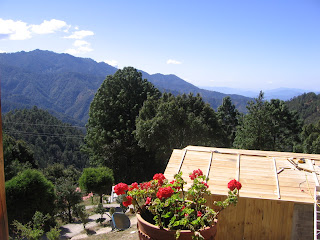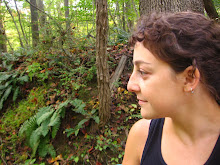 Today I write from San Cristobal de Las Casas, a small mountain town in the state of Chiapas. This place was made famous on January 1, 1994 when it was captured by the Zapatistas, a radical group fighting for indigenous people's rights in Chiapas. The Zapatistas, led by the pipe-smoking, masking-wearing Subcomandante Marcos, apologized to San Cristobal tourists for the incovenience, saying, "We're sorry, but this is a revolution."
Today I write from San Cristobal de Las Casas, a small mountain town in the state of Chiapas. This place was made famous on January 1, 1994 when it was captured by the Zapatistas, a radical group fighting for indigenous people's rights in Chiapas. The Zapatistas, led by the pipe-smoking, masking-wearing Subcomandante Marcos, apologized to San Cristobal tourists for the incovenience, saying, "We're sorry, but this is a revolution."Today, San Cristobal is a buzzing town of indigneous artisans, hippies who have adopted the town as their second home, and tourists from around the world. The Zapatista influence is still strong, but as the group has no ambition to overthrow the government ("We're indigenous and Mexican"), it is quite a tranquil area. Rebellious antics continue in pursuit of equal rights for indigenous Mexicans (1 out of every 4 people in Chiapas is Mayan) and in the hope of forcing the government to honor accords made with the indigenous peoples throughout the 1990s, but most are nonviolent and aimed directly at the landowners who persecute the indigenous people. There are lots of Zapatista-named stores, streets, and organizations in town. Many artisans sell Subcomandante Marcos t-shirts and other wares, but his status as a cult icon has shifted to that of Che Guevara-esque pop culture stardom.
Last night, I attended a Frida Kahlo documentary screening at a local independent film house. Before the show, a group of local children from the organization Sueniños performed a puppet show. They adapted traditional Latin American stories for the theater, working everyday after school on the project under the supervision of a handful of passionate volunteers. The kids are all younger than 10, come from the poorest areas in the city, and were in danger of failing out of school before they joined the program. It was quite an inspiring display, in contrast to the documentary which painted Frida as a poor victim of heartbreak. Although I disagree with the filmmaker's perspective that she was trapped in a marriage with a man who could not be blamed for his infidelity, the movie was still quite good. Several Kahlo experts were interviewed, and their perspectives provided a good balance to the bias of the narration.
After the movie last night, Andrea and I went to Bar Revolucion, where we heard some sappy live music but made a few new friends. We stayed out pretty late last night -- this town stays alive well past midnight. Although it's quite cold (we are 2100 meters above sea level), the air is so fresh it's hard to avoid staying outside until all hours.
Tomorrow, I am headed to Palenque and then it's east to Guatemala for a couple days in the Tikal/Flores area. I am excited to keep traveling, but I have fallen in love with this town. I could definitely see myself coming back here to volunteer at a local school or work on some sort of community development project.
 The energy here is great. There are a lot of open minded folks, diverse restuarants, lots of bookstores, and -- of course -- great local crafts. The streets and sidewalks are narrow, but cobblestoned in the European style. The days are cool, but the sun is strong. It feels like winter in the shade, but Mexican summer in the sun. Hostels are cheap (40 pesos per night), the food is good (I bought a Vietnamese stiry fry dish for 60 pesos and got two meals out of it), and everything is clean. Chiapas is Mexico's poorest state, so you can really see the positive impact tourism has made on the local economy. But keeping things eco-friendly is a challenge. Also, the surrounding indigenous towns host tour groups several times a day and while it would be cool to observe the locals who drink soda to keep evil spirits at bay, it's a challenging ambition to observe and respect simultaneously. I opted out of the 100 peso guided horseback tour to San Juan de Chamula. Making people into a stop on a guided tour is a dangerous habit... I think it dehumanizes people and makes them into objects of entertainment, which is contrary to the ideals of most of the tourists here in the first place. Then again, this is the same issue that you always confront when chasing intercultural interaction, and the only solution is to simply be careful of yourself, your fellow tourists, and the impression you leave on the people you visit.
The energy here is great. There are a lot of open minded folks, diverse restuarants, lots of bookstores, and -- of course -- great local crafts. The streets and sidewalks are narrow, but cobblestoned in the European style. The days are cool, but the sun is strong. It feels like winter in the shade, but Mexican summer in the sun. Hostels are cheap (40 pesos per night), the food is good (I bought a Vietnamese stiry fry dish for 60 pesos and got two meals out of it), and everything is clean. Chiapas is Mexico's poorest state, so you can really see the positive impact tourism has made on the local economy. But keeping things eco-friendly is a challenge. Also, the surrounding indigenous towns host tour groups several times a day and while it would be cool to observe the locals who drink soda to keep evil spirits at bay, it's a challenging ambition to observe and respect simultaneously. I opted out of the 100 peso guided horseback tour to San Juan de Chamula. Making people into a stop on a guided tour is a dangerous habit... I think it dehumanizes people and makes them into objects of entertainment, which is contrary to the ideals of most of the tourists here in the first place. Then again, this is the same issue that you always confront when chasing intercultural interaction, and the only solution is to simply be careful of yourself, your fellow tourists, and the impression you leave on the people you visit.I'll leave you with that thought. But for your entertainment, here are a couple photos from this past week.

Jessica visited me last week, and we went to Oaxaca, which was quite cool. We also visited Monte Alban, the ruins outside Oaxaca City, perched on a mountain top. Check it out -- no other tourists. It was beautiful.

After Jess headed back to the States, Erick and I went back to Oaxaca State and visited San Jose del Pacifico. This tiny, tiny town is located on the edge of some incredible Oaxacan peaks. We rented a cute little cabin. This is the view from our front door.

We had to wait for a loooooong time to get a bus back to Oaxaca City, but we kept ourselves entertained. Behold, the first blog picture of Erick.

I met up with Andrea in Oaxaca City, and we took an overnight bus to Tuxtla Gutierrezx. From there, we took the short ride to Chiapa del Corzo, a small town beside a huge canyon. We toured el Cañon del Sumidero by boat, and I was luckily able to snap some amazing photos. We saw a lot of crocodiles, too.
